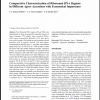
Autores:
Tamayo-Ordóñez Y. J.
Sánchez-Teyer L.F.
Narváez-Zapata J.
Revista y/o libro:
Plant Molecular Biology Reporter
Año:
2015
Sinopsis:
Two Ribosomal DNA Regions (5S And 18S) Were Characterized In Three Economically Important Species Of Agave Linnaeus, 1753 Namely A. Tequilana Weber, 1902; A. Angustifolia Haworth, 1915 And A. Fourcroydes Lemaire, 1864 Which Are Used To Produce Several Products Such As Tequila, Mezcal And Hard Fibers. Characterization Included Agave L. Accessions With Different Ploidy Levels (2n=2x=60 To 2n=6x=180) In Order To Relate This Factor To Different Rdna Sequence Traits Such As Copy Number, Haplotype Number, Expression Profile And Predictable Functionality. Only Total Rdna Copy Number (5S And 18S) Was Related With Ploidy Level. Main Differences Were Found In The 5S Rdna Gene Since It Exhibited Different Genetic Traits Of Agave L. Accession. In This Gene Four Different Allelic Groups (I: 105 Pb, II: 107 Pb, III: 110 Pb And IV: 111 Pb) Were Detected, Which Have Probably Evolved Separately, Thus Exhibiting Different Expression Profiles, And Different Haplotype Occurrence. Allelic Groups III And IV Exhibit The Highest Number Of Total And Expressed Copies In All Agave L. Accessions. Non-Redundant Haplotypes Were Probably More Functional In These Allelic Groups. Differences Between The Agave L. Accessions Were More Clearly Observed In The Most Cultivated Accession, A. Tequilana (2n=2x=60), Where The Allelic Group III Shows Non-Redundant Haplotypes And Is Transcriptionally Up-Regulated Suggesting A Different Evolutionary Pressure On This Agave L. Accession.